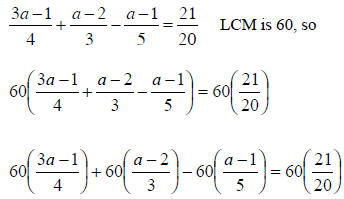Study Guide for Intermediate Algebra
Lesson 1
Properties of Real Numbers and Linear Equations
Lesson Objectives
After completing this lesson, students will be able to do the following:
1. Use the distributive property and other properties that are presented
2. Solve linear equations including those with fractions and decimals
3. Solve and apply formulas
4. Solve percent problems
Reading Assignment
Read pages 35–40, 54–59, 65–69.
Important Terms
| distributive property identity property associative property algebraic expressions linear equation addition and multiplication properties of equality inverse property |
commutative property multiplication property of 0 algebraic equations formula first-degree equations fractional equations |
Lecture
Note: This is a good time to become familiar with your textbook. You will
notice that the important
words and/or concepts are highlighted in bold text and in blue boxes. You may
find it helpful to put this
information on 3 x 5 index cards and make yourself a set of “flash cards” as a
study tool. Also, when I
assign practice or written problems, I will just give you the first page number
even though the problems
may be spread out over two or three pages.
1.4 Properties of Real Numbers
♦ Real numbers are the numbers we work with every day. These include integers,
fractions and
decimals . Please don’t let the language of mathematics scare you off!
♦ The distributive property is incredibly important. Be sure you understand how
to use it. While the
other properties listed are important, I don’t really care if you know their
names. It’s more important
that you know how and when to use them, and that will come with practice.
♦ Be sure you can recognize like terms .
♦ Although the book hasn’t made a big deal about it, I think it is time to point
out the difference
between terms and factors .
1. Factors are the numbers and/or variables being
multiplied together.
Example:
–5abc has factors of –5, a, b, and c.
2. A term is an indicated product that may have any number
of factors.
Example:
In 7xy + 5abc, 7xy is a term with factors 7, x, and y. 5abc is a term with
factors 5, a, b, and c.
♦ As a general rule, terms are separated by a + or – sign.
Practice Problems
Work page 41, #1–10, 11, 15, 19, 23, 27.
(Answers to even-numbered problems are given toward the back of this study
guide.)
2.1 Linear Equations in One Variable
♦ An expression does not contain an equal sign. It can only be simplified.
It is considered an algebraic
expression when it contains variables such as x or y.
♦ An equation does contain an equal sign . Equations must be solved. An algebraic
equation contains
at least one variable .
♦ You will see the term linear equation used frequently. What makes an equation
linear is the fact that
the variable is never raised to a power other than one. When the power (or
exponent) of a number or
variable is one, we generally don’t write it. For example: x1 is the same as x.
For this reason, these
equations are sometimes called first-degree equations.
♦ As you read through this material, take your time! These are the building
blocks for much of what we
will do during the course. It is essential that you understand the concepts.
♦ You can do anything you want to an equation as long as you do it to both
sides.
♦ I really like the way this text explains solving equations involving fractions
(I call these fractional
equations) and decimals.
♦ Here is another example of a fractional equation:

15(3a – 1) + 20(a – 2) – 12(a – 1) = 3(21)
45a – 15 + 20a – 40 – 12a + 12 = 63
53a – 43 = 63
53a = 106
a = 2
Practice Problems
Work page 61, #9–41 (every other odd), 43, 49, 55, 59.
2.2 Formulas
♦ Solving formulas for a specific variable is not only fun, it is also very
useful. I like to call these
manipulation problems because you are manipulating the formula to make it useful
for you!
♦ Percent problems always give people trouble. Percent is from Latin: per means
“by,” centum, “one
hundred.” This means, for us, “by hundreds.”
♦ I teach my students that percent is the part divided by the whole. In this
text, the authors say the same
thing, but they phrase it differently, saying that percent is the partial amount
(a) divided by the whole
amount (b). What you need to do is figure out what makes sense to you and use
that.
Practice Problems
Work page 72, #7–17 odd, 21, 27, 35, 37.
Written Assignment
Please read the Appendix in the back of this study guide
for essential Independent Study in
Idaho policies and procedures, and forms you will need to successfully complete
this course.
You are responsible for understanding and following ISI policies and procedures.
If there is
anything on these pages you do not understand, contact the ISI office for
clarification. Before
starting the written assignment for Lesson 1, see the letter in your
registration packet for your
instructor’s requirements: how to format and submit lessons, number of lessons
you may
submit at one time, and lesson guidelines.
Work the following pages and problems: (10 points)
42 (#34, 36)
62 (#24, 32, 54, 62)
72 (#16, 22, 28, 36)
| Prev | Next |